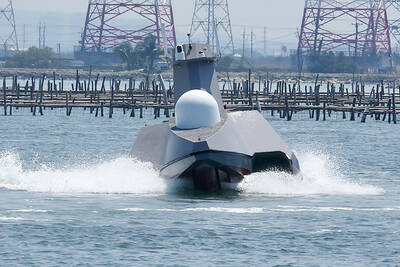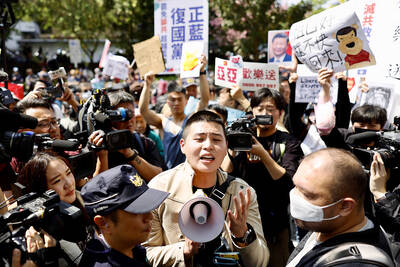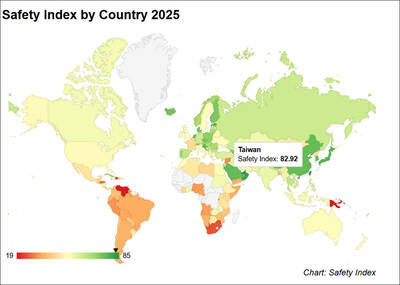The Mainland Affairs Council (MAC) yesterday expressed regret, saying former president Ma Ying-jeou (馬英九) has harmed the nation’s sovereignty and dignity by echoing the “one China” principle advocated by the Chinese Communist Party (CCP), which seeks to annex Taiwan.
In a speech at China’s Hunan University yesterday, Ma said “it is a clear fact” that the constitution of the People’s Republic of China (PRC), adopted in 1982, stipulates that “Taiwan is part of the sacred territory of the People’s Republic of China.”
Ma said “our country” amended the constitution, so that “our country was divided into two parts — one is the Taiwan Area, and the other is the Mainland Area — both are [parts of] our Republic of China [ROC], both are [parts of] China.”

Photo: CNA
According to Article 2 of the Act Governing Relations Between the People of the Taiwan Area and the Mainland Area (臺灣地區與大陸地區人民關係條例), “Taiwan Area” refers to Taiwan, Penghu, Kinmen and Matsu, while the “Mainland Area” refers to ROC territory outside the Taiwan Area, Ma said.
Therefore, based on the ROC Constitution, Taiwan and the mainland belong to one China, he said.
“We are the Taiwan Area, and you are the Mainland Area,” Ma said.
He said he was aware that “the Preamble of the 1982 Constitution on the mainland also mentions ‘Taiwan is part of the sacred territory of the PRC,’” and “this is a clear fact.”
By mentioning the PRC Constitution, which claims that “Taiwan is part of the sacred territory of the PRC,” and the ROC Constitution in the same breath, and saying that people on both sides of the Taiwan Strait adhere to the “one China principle,” Ma has harmed the nation’s sovereignty and dignity, the council said, adding that he seriously deviated from the fact that Taiwan has never been a part of the PRC.
The cross-strait “status quo,” and the consensus among Taiwan’s ruling and opposition parties, as well as the 23 million Taiwanese, is that “the ROC and the PRC are not subordinate to each other,” it said.
“The ROC is a sovereign nation, not part of the PRC,” the council said, adding that it hopes former presidents who visit China defend Taiwan’s sovereignty, dignity and interests, and meet the public’s expectations.
Cross-Strait Policy Association researcher Wu Se-chih (吳瑟致) said the ROC Constitution refers to “existing national boundaries,” but Ma deliberately cited the PRC constitution.
To some extent, Ma was also echoing the concept of “one China with respective interpretations,” attempting to put a spin on the Chinese Nationalist Party’s (KMT) so-called “1992 consensus.”
The “1992 consensus” is a term former Mainland Affairs Council chairman Su Chi (蘇起) in 2006 admitted making up in 2000, which refers to a tacit understanding between the KMT and the Chinese government that both sides of the Taiwan Strait acknowledge there is “one China,” with each side having its own interpretation of what “China” means.
Wu said it was “very inappropriate” for Ma, as a former president, to use the constitutions of both sides of the Taiwan Strait to deal with the “one China” issue.
Ma’s trip to China did not highlight the fact that the ROC exists, but instead echoed the CPP’s claim that “Taiwan is an inseparable part of Chinese territory,” he said.
Ma’s statements do not match the reality of the international situation and the fact that the ROC has sovereignty, Wu said, adding that Ma did not request the CPP to recognize the ROC.

ENDEAVOR MANTA: The ship is programmed to automatically return to its designated home port and would self-destruct if seized by another party The Endeavor Manta, Taiwan’s first military-specification uncrewed surface vehicle (USV) tailor-made to operate in the Taiwan Strait in a bid to bolster the nation’s asymmetric combat capabilities made its first appearance at Kaohsiung’s Singda Harbor yesterday. Taking inspiration from Ukraine’s navy, which is using USVs to force Russia’s Black Sea fleet to take shelter within its own ports, CSBC Taiwan (台灣國際造船) established a research and development unit on USVs last year, CSBC chairman Huang Cheng-hung (黃正弘) said. With the exception of the satellite guidance system and the outboard motors — which were purchased from foreign companies that were not affiliated with Chinese-funded

PERMIT REVOKED: The influencer at a news conference said the National Immigration Agency was infringing on human rights and persecuting Chinese spouses Chinese influencer “Yaya in Taiwan” (亞亞在台灣) yesterday evening voluntarily left Taiwan, despite saying yesterday morning that she had “no intention” of leaving after her residence permit was revoked over her comments on Taiwan being “unified” with China by military force. The Ministry of the Interior yesterday had said that it could forcibly deport the influencer at midnight, but was considering taking a more flexible approach and beginning procedures this morning. The influencer, whose given name is Liu Zhenya (劉振亞), departed on a 8:45pm flight from Taipei International Airport (Songshan airport) to Fuzhou, China. Liu held a news conference at the airport at 7pm,

Taiwan was ranked the fourth-safest country in the world with a score of 82.9, trailing only Andorra, the United Arab Emirates and Qatar in Numbeo’s Safety Index by Country report. Taiwan’s score improved by 0.1 points compared with last year’s mid-year report, which had Taiwan fourth with a score of 82.8. However, both scores were lower than in last year’s first review, when Taiwan scored 83.3, and are a long way from when Taiwan was named the second-safest country in the world in 2021, scoring 84.8. Taiwan ranked higher than Singapore in ninth with a score of 77.4 and Japan in 10th with

GRIDLOCK: The National Fire Agency’s Special Search and Rescue team is on standby to travel to the countries to help out with the rescue effort A powerful earthquake rocked Myanmar and neighboring Thailand yesterday, killing at least three people in Bangkok and burying dozens when a high-rise building under construction collapsed. Footage shared on social media from Myanmar’s second-largest city showed widespread destruction, raising fears that many were trapped under the rubble or killed. The magnitude 7.7 earthquake, with an epicenter near Mandalay in Myanmar, struck at midday and was followed by a strong magnitude 6.4 aftershock. The extent of death, injury and destruction — especially in Myanmar, which is embroiled in a civil war and where information is tightly controlled at the best of times —